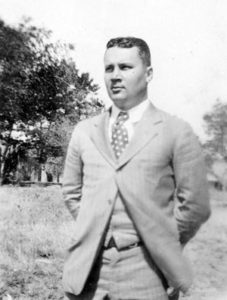
Coach Henry Frnka led the Greenville football team to win two Semi-Final Championships in 1931 and 1932. The in 1932 the team won Texas State Football Championship as the best in the entire state. The winning teams were a great morale booster for Greenville and Hunt County citizens during the Great Depression of the 1930s. Many of the players went on to become heroes in World War II.
On Friday before Labor Day this year, Greenville High School held its first Tailgate Party before beating North Garland High School 40 to 27 in a great football game. What a splendid way to begin a new school year!
Football grew in popularity in Greenville during the 1930s, a time of few pleasures for most people; with few distractions from falling agricultural prices, rising unemployment, and growing poverty. In the summer of 1931 a new football coach arrived in town. Henry Frnka joined Dennis Vinzant as coaches at Greenville High School. Together the two men and a group of talented athletes gave Greenville citizens something to cheer about. The football team went to semi-finals in both 1931 and 1932. In 1932 they earned the title of State Championship, the first and only time in the history of Greenville.
But the athletic rules in the 1930s were quite different from those in the second decade of the 21st century. Grades were not regarded as important when recruiting a team. Good strong boys who worked hard were necessary. It has been rumored that some of the team did not attend school in Hunt County in 1930. Dean Hallmark, an outstanding player and later World War II hero, came from Robert Lee, a small town in Coke County. The story goes that his father, a cattle raiser there, was offered a job in Greenville as a cattle buyer if he would relocate his family here and enroll Dean in high school.
Other team members lived with families throughout the county. These boys and their parents were encouraged to allow the young men to live in Greenville and attend Greenville High School. Whether these rumors were true or not, the players were extremely strong.
Games were played at Phillips Field at the east end of Jordan Street near the Cotton Belt Railroad Depot. Mrs. Eula Phillips, widow of wealthy banker Frank J. Phillips, donated funds to purchase and erect an athletic field for Greenville High School students in the late 1920s. When the Phillips field opened electric lights were not needed. All games were held on Saturday afternoon. Yet by the time Coach Frnka took charge, evening football games became more and more prevalent.
At that time, the school district and power company were under the city umbrella. Frnka asked the Mayor and City Council for electricity for the field. That was not a problem; the city would furnish wires and poles. Frnka agreed that the team would install the poles over the weekend so there would be lights for the following Friday night. The young men pitched in, dug holes, moved and installed poles in no time. Soon Phillips Field was electrified.
If you have a tendency to feel the young men were over exerted, remember that Greenville High School in the 1930s was located on Wesley Street where the GEUS Service Center is today. Each day the team ran from there down to Phillips Field for practice, and then back up the hill to change and go home. No buses or car rides for those guys.
